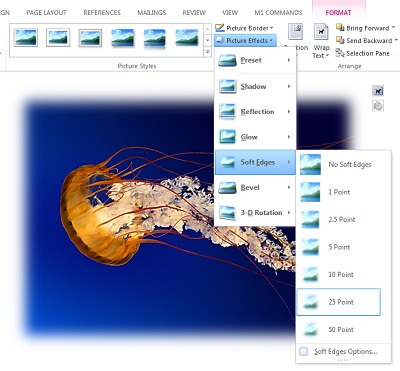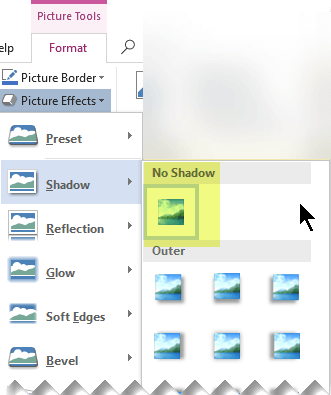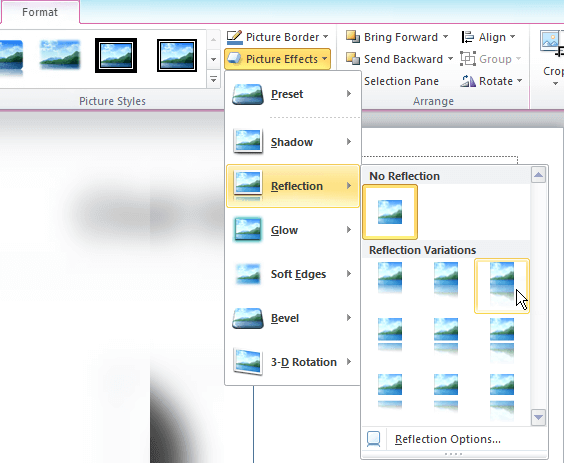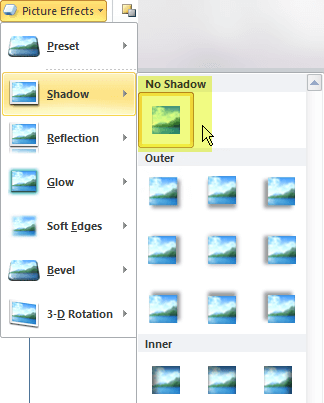Add or change an effect for a picture
You can enhance your picture by adding effects, such as shadows, glows, reflections, soft edges, bevels, and three-dimensional (3-D) rotations to it.
You can also add an artistic effect to a picture or change the brightness, contrast, or sharpness of a picture.

Add an effect to a picture
-
Select the picture for which you want to add or change an effect.
Note: To add the same effect to multiple pictures, click the first picture, and then press and hold CTRL while you click the other pictures. If you are using Word, you must copy the pictures to a drawing canvas if they are not already there. Click Insert > Shapes > New Drawing Canvas. (After adding or changing the effect, you can copy them back to the original location in your document.)
-
Under Picture Tools, on the Format tab, in the Picture Styles group, click Picture Effects.
-
Rest your pointer on one of the Picture Effects options to see a menu of different ways to apply each effect. When you rest your pointer on one of the menu effects, the effect appears as a preview on the picture in your document.

Notes:
-
To customize the effect you're adding, click the Options selection at the bottom of each effect menu. For example, if you've opened the Shadow menu, click Shadow Options to make custom adjustments to the shadow effect.
-
If you do not see the Picture Tools or Format tabs, double-click the picture to make sure that you selected it. If you see [Compatibility Mode] next to the file name at the top of the program window, try saving your document into a format such as *.docx or *.xlsx instead of an earlier file format such as *.doc or *.xls, and then try again.
-
Remove an effect from a picture
Each category of picture effect has a No <Effect Name> option at the top of its menu. Select that option to turn off an effect that you don't want.
For example, to remove a shadow, point to Picture Effects > Shadow > No Shadow.
-
Select the picture for which you remove an effect.
-
Under Picture Tools, on the Format tab, in the Picture Styles group, select Picture Effects.
-
Select the Picture Effects category that you want to remove. In the menu that appears, the first option is No <Effect Name> (such as No Shadow or No Reflection). Select that option to remove that kind of effect from the picture.

You can enhance your picture by adding effects, such as shadows, glows, reflections, soft edges, bevels, and three-dimensional (3-D) rotations to it.
You can also add an artistic effect to a picture or change the brightness, contrast, or sharpness of a picture.

-
Click the picture for which you want to add or change an effect.
Note: To add the same effect to multiple pictures, click the first picture, and then press and hold CTRL while you click the other pictures. If you are using Word, you must copy the pictures to a drawing canvas if they are not already there. Click Insert > Shapes > New Drawing Canvas. (After adding or changing the effect, you can copy them back to the original location in your document.)
-
Under Picture Tools, on the Format tab, in the Picture Styles group, click Picture Effects.

If you do not see the Picture Tools or Format tabs, double-click the picture to make sure that you selected it. If you see [Compatibility Mode] next to the file name at the top of the program window, try saving your document into a format such as *.docx or *.xlsx instead of an earlier file format such as *.doc or *.xls, and then try again.
-
Do one or more of the following:
-
To add or change a built-in combination of effects, point to Preset, and then click the effect that you want.
To customize the built-in effect, click 3-D Options, and then adjust the options that you want.
-
To add or change a shadow, point to Shadow, and then click the shadow that you want.
To customize the shadow, click Shadow Options, and then adjust the options that you want.
-
To add or change a reflection, point to Reflection, and then click the reflection variation that you want.
To customize the reflection, click Reflection Options, and then adjust the options that you want.
-
To add or change a glow, point to Glow, and then click the glow variation that you want.
To customize the glow colors, click More Glow Colors, and then choose the color that you want. To change to a color that is not in the theme colors, click More Colors, and then either click the color that you want on the Standard tab, or mix your own color on the Custom tab. Custom colors and colors on the Standard tab do not update if you later change the document theme.
To customize the glow variation, click Glow Options, and then adjust the options that you want.
-
To add or change a soft edge, point to Soft Edges, and then click the size of the soft edge that you want.
To customize the soft edges, click Soft Edges Options, and then adjust the options that you want.
-
To add or change an edge, point to Bevel, and then click the bevel that you want.
To customize the bevel, click 3-D Options, and then adjust the options that you want.
-
To add or change a 3-D rotation, point to 3-D Rotation, and then click the rotation that you want.
To customize the rotation, click 3-D Rotation Options, and then adjust the options that you want.
Notes:
-
For additional information about the options in these panes, click Help
 at the top of the Format Picture dialog box.
at the top of the Format Picture dialog box.
-
-
Remove an effect from a picture
Each category of picture effect has a No <Effect Name> option at the top of its menu. Select that option to turn off an effect that you don't want.
For example, to remove a shadow, point to Picture Effects > Shadow > No Shadow.
-
Select the picture for which you remove an effect.
-
Under Picture Tools, on the Format tab, in the Picture Styles group, select Picture Effects.
-
Select the Picture Effects category that you want to remove. In the menu that appears, the first option is No <Effect Name> (such as No Shadow or No Reflection). Select that option to remove that kind of effect from the picture.

You can enhance your picture by adding effects, such as shadows, glows, reflections, soft edges, bevels, and three-dimensional (3-D) rotations to it.
You can also add an artistic effect to a picture or change the brightness, contrast, or sharpness of a picture.
-
Click the picture for which you want to add or change an effect.
Note: To add the same effect to multiple pictures, click the first picture, and then press and hold CTRL while you click the other pictures. If you are using Word, you must copy the pictures to a drawing canvas if they are not already there. Click Insert > Shapes > New Drawing Canvas. (After adding or changing the effect, you can copy them back to the original location in your document.)
-
Under Picture Tools, on the Format tab, in the Picture Styles group, click Picture Effects.

If you do not see the Picture Tools or Format tabs, double-click the picture to make sure that you selected it. If you see [Compatibility Mode] next to the file name at the top of the Office Excel 2007 window, try saving your document as an 2007 Microsoft Office system document instead of an Office 2003 document, and then try again.
-
Do one or more of the following:
-
To add or change a built-in combination of effects, point to Preset, and then click the effect that you want.
To customize the built-in effect, click 3-D Options, and then choose the options that you want. For additional information about the options in the 3-D Format pane, click Help
 at the top of the Format Picture dialog box.
at the top of the Format Picture dialog box. -
To add or change a shadow, point to Shadow, and then click the shadow that you want.
To customize the shadow, click Shadow Options, and then choose the options that you want. For additional information about the options in the Shadow pane, click Help
 at the top of the Format Picture dialog box.
at the top of the Format Picture dialog box. -
To add or change a reflection, point to Reflection, and then click the reflection variation that you want.
-
To add or change a glow, point to Glow, and then click the glow variation that you want.
To customize the glow colors, click More Glow Colors, and then choose the color that you want. To change to a color that is not in the theme colors, click More Colors, and then either click the color that you want on the Standard tab, or mix your own color on the Custom tab. Custom colors and colors on the Standard tab do not update if you later change the document theme. For more information about themes, see All about themes, Quick Styles, cell styles, and background styles.
-
To add or change a soft edge, point to Soft Edges, and then click the size of the edge that you want.
-
To add or change an edge, point to Bevel, and then click the bevel that you want.
To customize the bevel, click 3-D Options, and then choose the options that you want. For additional information about the options in the 3-D Format pane, click Help
 at the top of the Format Picture dialog box.
at the top of the Format Picture dialog box. -
To add or change a 3-D rotation, point to 3-D Rotation, and then click the rotation that you want.
To customize the rotation, click 3-D Rotation Options, and then choose the options that you want. For additional information about the options in the 3-D Rotation pane, click Help
 at the top of the Format Shape dialog box.
at the top of the Format Shape dialog box. -
To remove an effect that you've added to the picture, point to the menu entry for the effect, and then click the option to remove the effect. For example, to remove a shadow, point to Shadow, and then click No Shadow.
-
No comments:
Post a Comment